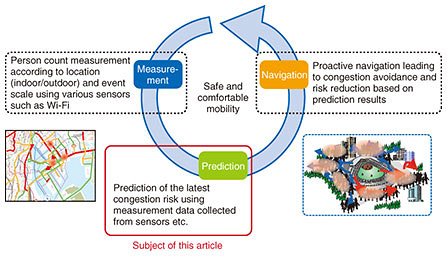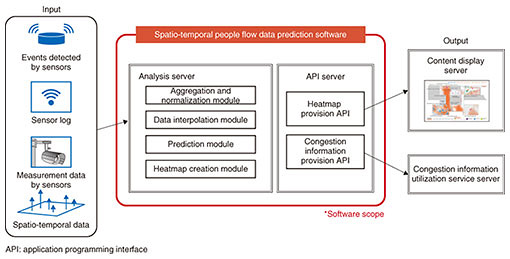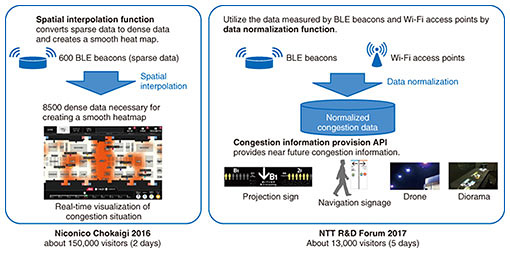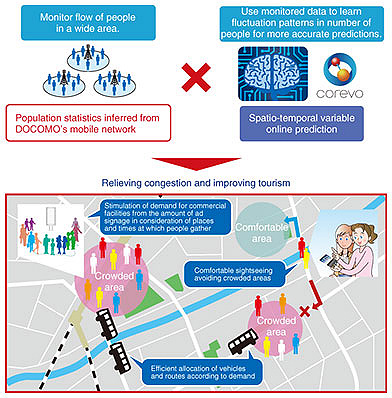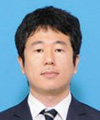 |
|||||||||||||||||
|
|
|||||||||||||||||
|
Feature Articles: NTT”Ēs Artificial Intelligence Evolves to Create Novel Services Vol. 16, No. 8, pp. 47–52, Aug. 2018. https://doi.org/10.53829/ntr201808fa8 People Flow Prediction Technology for Crowd NavigationAbstractWe are investigating the use of incomplete observation data in order to predict the large-scale flow of people for major events such as the Olympic Games and to derive guidance measures in advance to prevent the occurrence of congestion. In this article, we introduce a spatio-temporal variable online prediction algorithm for forecasting congestion risk, and we explain our research and development efforts to utilize the algorithm. Keywords: spatio-temporal data analysis, congestion risk prediction, artificial intelligence 1. IntroductionCongestion often occurs in places such as tourist regions, commercial areas, and large event spaces where many people gather, and it is conceivable that the congestion will be severe enough in some cases to lead to a major accident. It is therefore very important to provide crowd navigation to help move people along safely and comfortably in such places. This can be done by grasping the whole flow of people in the area, forecasting in advance the occurrence of congestion caused by complex factors, and navigating crowds by taking the appropriate measures. In addition, because the behavior of people changes as they move about, by repeating the cycle of grasping the flow of people that has changed and predicting where congestion will occur next, it is possible to properly navigate the continuously changing people flows (Fig. 1).
In this article, we first describe a spatio-temporal variable online prediction algorithm that is applied to predict flows of people in a series of cycles. Then we introduce software that incorporates the prediction technology and explain various approaches to utilizing it. 2. Spatio-temporal variable online predictionIt is important to predict the congestion risk in advance in crowded places such as large events where many people gather. There are several tasks involved in predicting congestion risk. For example, there are tasks to predict in advance the peak congestion time and the size of congestion in places such as entrances that are known to be crowded, as well as tasks to predict the occurrence of unexpected congestion for which we do not know when or where it will happen. We applied our spatio-temporal variable online prediction algorithm to solve the latter prediction problem [1]. An overview of the processing flow of this prediction algorithm is shown in Fig. 2. The input of the algorithm is spatio-temporal observation data of the area where the congestion is observed (Fig. 2(a)). For example, this includes position data using GPS (Global Positioning System) and person-count data by position sensors installed at the event site.
Next, spatial data are generated by estimating missing values for each observation time (Fig. 2(b)). With the spatial data of the time series created in this way, we can construct a latent structural model that captures the characteristics of the area common to each time (Fig. 2(c)). This model expresses the latent structure of people flow, and by fitting the model to the input data at each time, the fluctuation in the flow of people can be regarded as a fluctuation of a latent structure. Learning this fluctuation pattern makes it possible to predict the people flow that will occur in the near future (Fig. 2(d)). The conventional method used for prediction is based on the assumption that data that are spatially and temporally near each other are similar, and this made it difficult to predict sudden fluctuations. However, the spatio-temporal variable online prediction algorithm learns the time-series fluctuation pattern in the latent structural model, and it is therefore effective even when there is large fluctuation. 3. Spatio-temporal people flow data prediction softwareThe spatio-temporal people flow data prediction software has a function to visualize the current congestion situation from sensor data collected in real time and to predict future congestion situations by using the spatio-temporal variable online prediction algorithm based on accumulated spatio-temporal data. An overview of the software is shown in Fig. 3. The software processes data including general spatio-temporal data, events detected by Bluetooth Low Energy (BLE) beacons, the number of detected terminals by Wi-Fi access point logs, and the number of people measured by cameras. The input data are processed by the analysis server, and the results are output through the application programming interface (API) server. There are two kinds of output; the first is current and near future congestion density information, and the other is a heatmap image visualized by expressing congestion information in color.
Sensors for measuring congestion status have different levels of detection accuracy. It is assumed that multiple sensors will be used in combination, depending on the situation and purpose as well as the cost. This software, as a preprocessing step before prediction, has a function to absorb differences between different detection ranges and detection ratios for each sensor and to convert it into congestion information that can be handled uniformly. Thus, data from different types of measurement sensors can be combined and input. This is cost effective and results in higher detection accuracy. 4. Demonstration experiment at large eventsWe conducted a demonstration experiment using the spatio-temporal people flow data prediction software at two large events where a lot of people gathered (Fig. 4).
At Niconico Chokaigi 2016 held in April 2016, we provided services to notify the event operators, facility operators, and visitors of congestion risks by visualizing the congestion status [2, 3]. At this event, we installed about 600 BLE beacons at the venue, provided visitors with an application to upload data that received the radio waves from the beacons, and input the uploaded data to the system. At NTT R&D Forum 2017 held in February 2017, we set up BLE beacons and Wi-Fi access points in the hall and used data uploaded via the official application as system input [4, 5]. At this event, we provided value in various ways by providing current and predicted congestion information for other services via the API. At both these events, we used only the latest real-time sensor data acquired on the day to predict the congestion situation 20 minutes ahead. An accuracy evaluation was carried out after the experiment, and it was confirmed that this technique was able to predict large fluctuation of people flow more accurately than the conventional method. 5. Approach to practical application at NTT DOCOMONTT DOCOMO is currently investigating services that utilize this technology. The use of population statistics* inferred from DOCOMO’s mobile network together with the spatio-temporal people flow data prediction software makes it possible to predict in 10-minute units the number of people within a 250–500 m square area a few hours ahead [6] (Fig. 5).
Utilizing the present and near future numbers of people makes it possible to navigate people to places and routes that are not congested in tourist regions and commercial areas that are crowded. It also makes it possible to efficiently supply the appropriate means of transportation such as buses and taxis when a shortage arises in the supply of transportation. Also, in the event of a disaster or accident, it is expected that rescue teams will be dispatched efficiently according to the scale of the number of victims. At large events such as sports games and fireworks festivals, the nearest stations to the facility are crowded before the start, people concentrate around the facility during the event, and the flow of people spreads to the surrounding area after the event. Consequently, dynamic deployment of security guards using population distribution prediction in the near future can lead to strengthening accident/crime prevention measures.
6. Future outlookIn the future, we will continue to conduct trials and other efforts to make the people flow prediction technology more practical. In addition, we will continue further research and development so that we can provide more new value such as deriving proactive navigation to prevent congestion in advance. References
Trademark notesAll brand names, product names, and company names that appear in this article are trademarks or registered trademarks of their respective owners. |
|||||||||||||||||









